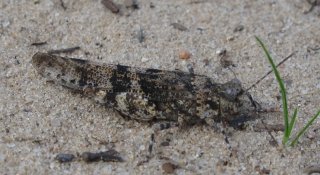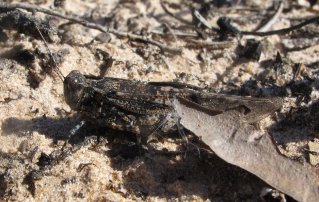Blue-winged grasshoppers return to Latvia after 50-year absence
The blue-winged grasshopper (Oedipoda caerulescens) is the 2013 Insect of the Year. This year, JSC Latvia’s State Forests environmental planning specialists Mārtiņš Kalniņš and Kaspars Liepiņš came across his relative – the slender blue-winged grasshopper (Sphingonotus caerulans) in the forests surrounding Lake Kaļņu in Gulbene Region.In the 1998 edition of Latvia’s Red Book, the most up-to-date source of information about these species, habitat maps are empty for both the blue-winged grasshopper and the slender blue-winged grasshopper. During the 2013 Insect of the Year campaign, the blue-winged grasshopper was found in several locations throughout the country. The above-mentioned area, however, is the only place in state forests where the slender blue-winged grasshopper has been spotted over the past 50 years and the only area of this kind in north-east Latvia.
“According to our data, the slender blue-winged grasshopper lives in open, dry and mostly sandy areas with sparse vegetation – dunes and heaths. Due to the fact that the species is incapable of long-distance flight, it is most likely that the slender blue-winged grasshopper has been living in this area for quite some time, making use of natural and man-made sand. In Gulbene Region, the slender blue-winged grasshopper was found in a three-year-old forest clearing, which is now a young pine forest stand. Dozens of grasshoppers observed in the area indicate favourable conditions for the species. Natural dunes and heaths in Latvia’s inland are a rare occurrence. Therefore all species connected with sand are mostly dependant on human activities (roadsides, fire safety belts, quarries and clearings). These pines will grow, and the slender blue-winged grasshopper will have to seek a new habitat,” explains Kalniņš.
“From the point of view of forest management, this area is a challenge. It is home to both of these rare and endangered grasshopper species, which depend on the existence of sand (roadsides, clearings and young forest stands), as well as two rare and endangered species of beetles Tragosoma depsarium and Boros schniederi, which require old pine forests (dry and decaying trees),” admits the expert.
Latvian grasshoppers and crickets are well-researched, compared to other groups of insects. They were studied by the world-famous entomologist of Liv origin - Kārlis Princis (1893-1978), who would mark his 120^th anniversary this year. However, information about the distribution of rare grasshopper species, including the blue-winged grasshopper and the slender blue-winged grasshopper, is incomplete. Therefore, everyone can significantly contribute to this research by reporting observations to the diary www.dabasdati.lv or Mārtiņš Kalniņš




